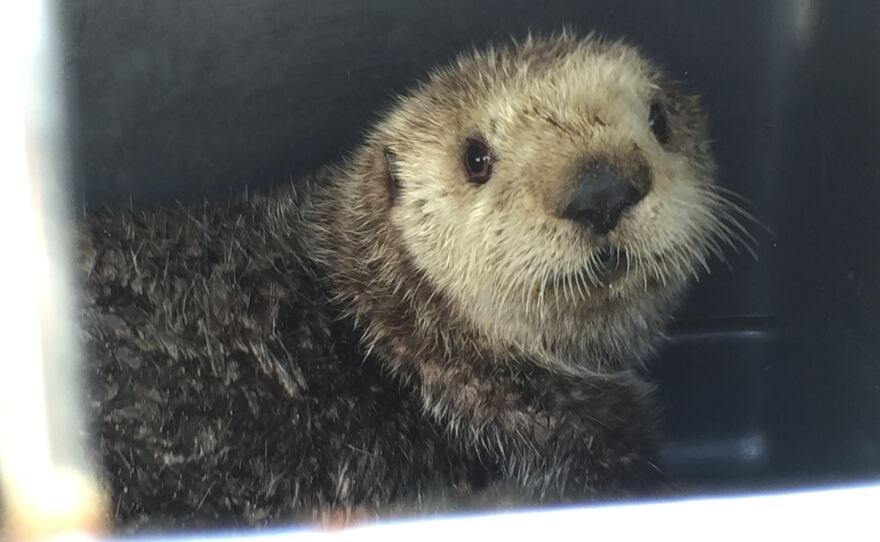Scientists continue to see large numbers of dead or sick sea otters turning up in the Kachemak Bay region. Officials with the U.S. Fish and Wildlife Service say the agency has received about 200 reports of sick or dead otters over the past couple of months. They’ve teamed up with the Alaska SeaLife Center in Seward and they’re running tests to try to find out the cause. Meantime, they’re asking for the public’s help. KBBI’s Daysha Eaton has more.
It’s Friday night and Marc Webber, with the U.S. Fish and Wildlife Service in Homer, has already had two calls for sick sea otters.
“Well I just was out on the spit having dinner with my family and a call came in as I was coming into the station of two otters ashore on mariner this evening,” said Webber.
Webber is part of a group trained to respond to sick and injured marine mammals. He’s Deputy Refuge Manager for the Alaska Maritime National Wildlife Refuge which runs the Alaska Islands and Ocean Visitors center in Homer.
“And so I was able to get to one of them down below the rock wall along the spit road and that individual is in very bad shape. It is in a somewhat depleted condition, but demonstrating something we’ve also seen a little bit of which is a set of neurological symptoms where it was twitching,” said Webber.
Webber and trained volunteers try to keep people away from sick otters and get a vet to euthanize them when necessary.
“We’re finding otters all over the Homer area. They’re found from outer Bishop’s Beach all the way around the spit on both sides and along the shores of Mud Bay, so pretty wide spread,” said Webber.
Otters play an important role in their habitat, Webber notes – they’re positioned at the top of the food web, so when something is going wrong with them, something is likely affecting the entire ecosystem.
Otters were nearly hunted to extinction during the fur trade of the 17 and 1800’s and suffered again after the Exxon Valdez oil spill. The sea otters in Kachemak Bay are part of a population that stretches from Cook Inlet to Prince William Sound.
In the 1970’s the Marine Mammal Protection Act safeguarded otter populations. Otters remain protected.
At last count (2012), the Kachemak Bay otter population was around 59-hundred. Carrie Goertz is a veterinarian with the Alaska SeaLife Center in Seward. She’s been examining sick otters.
“This summer started off fairly typical with a couple of otter carcasses or few otter carcasses being found every week. However as the summer went on into august and September we were getting up over 20 carcasses or moribund animals each week. And it’s in those animals that we’ve seen different presentations,” said Goertz.
She says they’ve been tracking a streptococcus illness in Kachemak Bay area otters for some time and those otters usually appear sickly and emaciated. But the otters that have died since August seem different.
“Most recently what we’ve seen more of is animals in a healthier condition that seem to have been taking care of themselves well but have died acutely and that has become more common in the ones that we’ve been seeing in the last couple of months,” said Goertz.

If you see a beached live otter or a dead one, officials want to know about it. They’re asking people to call the Alaska SeaLife Center Stranded Marine Mammal Hotline. They say otters shouldn’t be approached because streptococcus related illness can be passed to humans. Dogs should also be restrained, as the illness can be passed to them too. In addition, a sick otter could get defensive.
Webber, with the U.S. Fish and Wildlife Service in Homer says he’s responded to around 50 calls for dead and dying otters over the past couple of months, and what he’s seeing seems different than what he’s seen in the past.
“Something is hitting them harder and faster, in addition to the disease that we’re familiar with seeing, something else seems to be involved. That’s just speculation, we don’t have any evidence yet, but that’s what we’re seeing on the beach,” said Webber.
Officials with the Fish and Wildlife Service and the Alaska SeaLife Center say they’re waiting for lab tests to get back in the next few weeks.
Dead or dying sea otters and other marine mammals should be reported to the Alaska SeaLife Center’s Marine Mammal Stranding Network hotline at 888-774-SEAL (7325).



